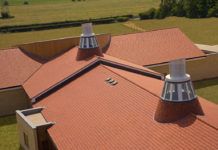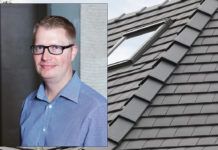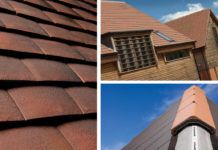

Continuing with my theme of answering some of the common questions encountered with pitch roofing, this month I consider questions that homeowners often ask about their roof. For roofers, it is worth having an understanding of these issues, as the homeowner will normally turn to their roofer first if there is a problem. Perhaps there is an opportunity for roofers, when re-roofing a home, to offer some form of maintenance contract. For example, an annual inspection with small maintenance items as part of the contract, similar to those offered for domestic gas, water and electrical systems.
Q. How often should a roof be inspected?
It is a good idea to inspect the internal structure of a roof (if accessible) at least once annually to check that it’s still watertight and there is no rot or woodworm infestation; repeat checks in different weather conditions. A check after heavy rain will reveal any water ingress due to defects in the roof system. A check in winter weather will reveal any condensation within the roof space.
When inspecting a roof from outside at ground level use binoculars to look for damaged or dislodged tiles. At the ridge and hip, check for missing ridge tiles and gaps in mortar. Check flashings around chimneys and at valleys, side and top abutments etc. Check valleys and gutters for debris such as broken tiles, mortar and vegetation growth.
Q. What about moss and lichen growth?
Mosses and lichens tend to flourish on roofs where trees are nearby and where there are shady, damp conditions. North facing slopes tend to remain damper longer, therefore mosses and lichens are often more prevalent than on the other roof slopes of a building. Steeper pitched roofs are less likely to support moss and lichen growth as they shed water more quickly than low-pitched roofs.
The primary effect of moss on a roof is that it holds water, thus impeding the flow of water to the gutters, so water stays in contact with the tiling for longer. Over a long period, this may have a detrimental effect on the roof tiles.
Generally, some minimal growth is not deleterious to the tile and can even impart a mellow and pleasing appearance. However, if mosses and lichens block the drainage of water in valleys, abutment gutters and the drainage channels of the roof tiles, it is better to remove the growth.
Where moss and lichen growth is considered undesirable, there are commercially available liquid treatments that will remove the growth and even prevent it from re-occurring for a period. Assuming that a competent person would carry out the work, with full and safe access, my advice would be to test any product on a small area first before treating the whole roof. Also, be aware of any potential environmental hazards that toxic materials may pose.
Q. What can be done about condensation in the roof space?
The most likely place for condensation to occur first in a roof structure is on the underside of the roof underlay. If condensation occurs in a correctly constructed roof structure, it may be a temporary overload through extreme weather conditions; eg cold, winter weather with little or no wind, with the heating on internally and windows closed to keep the heat in.
If the condensation is temporary and disappears without wetting other elements such rafters or insulation, then it may not be too much of a problem. However, if the condensation is long lasting or heavy enough to wet other elements or drip off onto the ceiling, then remedial action of some kind is required.
Condensation in the roof space can be due to either a) too much warm air entering the roof space from the living spaces and / or b) too little roof space ventilation. Often, the easiest way to reduce the problem is to introduce more ventilation into the roof space by installing tile ventilators. The location of the ventilators depends on several factors such as roof geometry and pitch, but as a simple guide, fit some in the tile courses just above the horizontal insulation at each side of the roof to aid cross-flow ventilation. Additional ventilators at high level would act to draw air in through the lower ventilators. For further information, contact Wienerberger’s Roof Technical Support Department at www.wienerberger.co.uk.
Q. What is roof tile ‘chatter’
Roof tile ‘chatter’ can sometimes occur in high winds when the tails of the tiles are lifted and dropped by the wind forces. The sound can be amplified by forms of roof construction where the ceiling is fixed directly to the rafters, such as ‘room in roof’ designs.
Tile clips can help to reduce the risk of chatter, though it is not usually possible to fit clips retrospectively and their use at the time of the roof installation would depend on the calculated wind loading / fixing specification.
Sometimes chatter is restricted to a small area of roof. Natural or artificial features nearby, or a roof feature such as a chimney or dormer windows, can affect wind speed or create turbulence causing uplift in a particular roof area. If such an area can be identified then it may be possible to secure the tails just in these areas by removing an area of tiling and re-fixing using screws and clips. The use of adhesive could also be considered, although extreme care is needed to avoid blocking interlocks and water channels and should be limited to small dabs at the tile tails to act as ‘cushions’.
Q. What is this white bloom on the roof tiles?
Although quite rare (roof tile manufacturers take steps during manufacture to prevent or at least limit this) a white bloom on concrete roof tiles is normally a result of efflorescence; a naturally occurring phenomenon in concrete. As rainwater wets the tiles, it can draw calcium hydroxide which forms during the hydration process of the cement, to the outer surface of the concrete. When the tiles dry, a white film, or bloom, becomes visible on the tile surface. If Efflorescence is to occur, it usually happens quite soon after the tiles are manufactured and installed and ceases just as quickly. Then subsequent rain and general weathering will act to remove the efflorescence and it will not re-occur.
efflorescence can also occur in mortar bedding at ridges and hips. Rainwater may wash the salts down the roof and deposit it on the roof tiles, leaving unsightly streaks. Again, this process soon stops and the streaks will eventually weather away. Of course, the best way to prevent efflorescence in the mortar is to use dry fix systems instead of mortar to secure the hip and ridge tiles.
It is impossible to predict how long the weathering will take to remove the efflorescence but there are commercially available liquid treatments that will remove the efflorescence faster than natural weathering. Assuming that a competent person would carry out the work with full and safe access, test any product on a small area first before treating the whole roof.
In summary, the roof is the primary structure that protects a home, so look after it. As well as preventing water ingress and wind damage, home insurance policies are normally only valid so long as the property is properly maintained.



